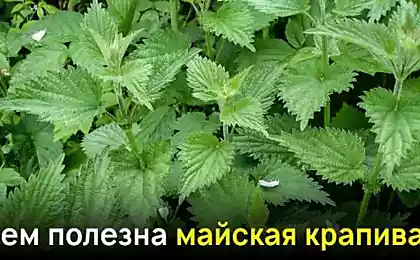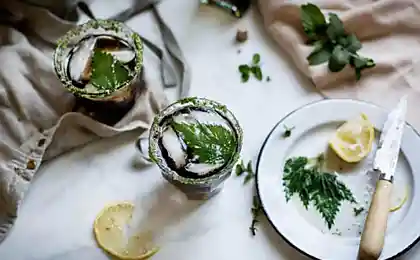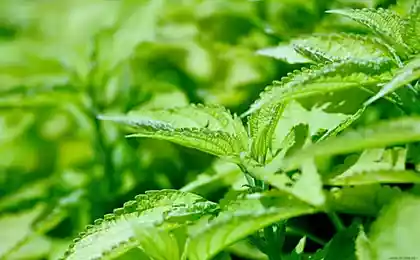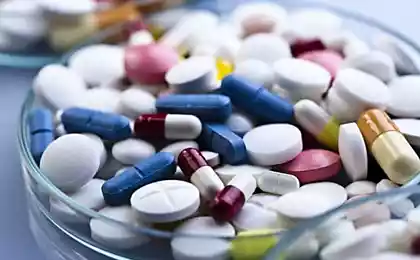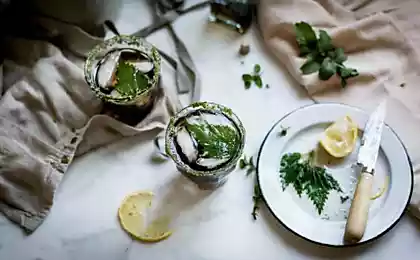1332
How is a yarn of nettle
Closer to spring some stalks nettle, especially broken by the wind, some places have to exfoliate the top layer of the cortex, which contains fiber.
Their flexibility and strength long appreciated the bird. For example, the crossbill is always looking for the wren to equip its winter nest.
Sparrow is a no-no, yes and grab nettle fibril for filling random cracks in insulated since the fall of the nest. Spring billet construction material in full swing wren-tit is Remez.
Its nest-cradle hanging over the water on a branch of willow. It is so strong that it is not destroyed for several years. I do not whether these birds craftsmen and advised the man to use a strong elastic fibers nettle?
Like flax and hemp, nettle - one of the oldest fiber plants, which man has learned to handle
.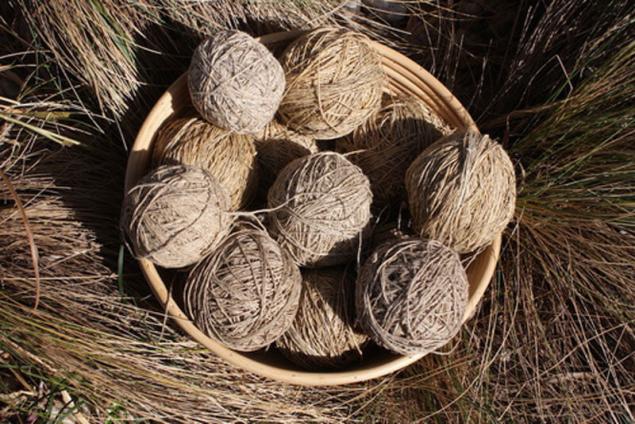
From long and strong fibers nettle produced yarn for fabric running on tailoring, sails and sacks. From it wove carpets, Vili and ropes, wove fishing nets. On the western shore of Lake Ladoga was found by archaeologists fishing net, woven from the threads of nettle in the Stone Age.
Many will recall Andersen fairy tale about how a girl rescued from the evil spell brothers, turned into wild swans. On the advice of her fairy godmother narwhal nettle, mash it stems napryala strands, and then produced from them-shirt of chain mail that returned a human face brothers. In the fairy tale it reflected old people's faith in the miraculous properties of the fabric of nettle fibers that can supposedly protect people from evil spells and the evil eye, and to heal various diseases. Wonder of nettle yarn to knit socks that are worn for rheumatic pain, belt, used for sciatica and migraine.
Gradually capricious stinging nettles pushed more complaisant flax and hemp. However, the memory of nettles as a fiber plant is still preserved somewhere in the depths of consciousness, sometimes appearing in children's games. In an ethnographic collection of the 19th century, it reported: "In the villages of the province of Ryazan girls spun fibers from nettles to produce thread, which was made from rags dresses for dolls, - finished the mother thread is not allowed." Perhaps, from a pedagogical point of view of the mother acted very wisely, not only because it reminded of the need to save, but because inadvertently teach children to needlework, craft. We can only guess: how the girls became known spinning properties of nettle fibers, which adults have long forgotten
? It is fair to say that nettle fibers were not forgotten by all adults. Even today, they are used for spinning yarn, preferring the purchased, the indigenous people of Kamchatka and the Amur region. Strong and durable thread go on weaving bags, baskets and a variety of boxes. In the manufacture of traditional products used willow twigs, wild rye stalks (tuveyki) and elm along with nettle threads. Quite often used and other fibrous plant growing on vacant lots and burned areas, - Cyprus uzkolisty, popularly called willow-tea
. With harvested in autumn willow-herb stems carefully remove the peel, divide it into fiber, dried and removed for storage. Part of the harvested material are stained broth collected in the swamp moss rusty containing iron oxide black. To make fibers gloss, staining solution added to fish oil. Alternating in a certain order light and dark fiber, masters decorate the surface of articles in geometric patterns.
In the old days of the willow-herb fibers Willy rope, matting produced, horse harness, burlap, and more. In people, the plant is often called wild hemp. This emphasized the similarity of its fibers, hemp fibers, cultivated in our country with the ninth century, called hemp. Nowadays, hemp is indispensable in the manufacture of marine rope, canvas, tarpaulin, fire hoses. But because of the narcotic substances contained in the plant, Hemp fell into disgrace. It is possible that in the near future, scientists will be able to replace it with the cultural views of fireweed uzkolistogo fibers which have similar properties. Perhaps there will turn and nettle, but for now, following the example of our ancestors, produce their own hands krapivnuyu tow.
Nettle tow
All though vaguely heard but how hard it is to harvest and process the flax and hemp. Nettles too, if you do it, as it should be, in the autumn. Then it needs to be dried, then soaked for a long time, again dried, to obtain finally the most trust (the so-called-dried and peeled stalks of fibrous plant), from which it is extracted and spinning fibers. And if you collect nettles in the winter and in the first half of spring, you'll have almost finished trust: nature itself - biting rain, dew, frost, fog and winter thaw has worked for you ...
Brought to the wasteland of nettle stalks should be well dried, spread out on the stove or next to a radiator. Then, remove the twigs and dried leaves. To check the quality of the resulting trusts, knead it with your fingers and is breaking in several places. Ready trust should break apart in his hands with a slight crash, and fiber - separated from the woody parts of the stalk
. OBMINANIE.
The treatment begins with obminaniya trusts her special Myalitsa. On how faithfully mashed stems, yarn quality depends. Not domnesh Mälk, so do not take the spinning wheel - warned the peasant proverb. Myalitsa or Mälk, for the treatment of a small number of trusts in the home, you can make your own - it consists of four parts (Figure 1a.). By the wooden base 20 mm thick attached screws E two boards with saddle notch. From inside the cutout in each field plates mowed at 45 degrees. Lever or beater, slightly tapered bottom and fastened to Myalitsa with the bolt. In turn, strengthen the foundation Myalitsa screws on the bench or any other stable support. For a time in the Myalitsa can knead just one handful of trusts, that is as much as can fit in the hand. Begin to trust press down with one of the ends, put her in the saddle-shaped cut-out with a raised arm. Each time you press and the subsequent lifting of this trust lightly rotate and advance forward slightly. So do as long as a handful of trusts will not be fully obmyata.
Obminanie trusts is more dispute if instead Myalitsa use homemade three-shaft or twin-shaft Mälk (Fig. 1 b). Although the work for them and one can, together still more convenient and faster. One lays the trust between the shafts and the other turns the handle and takes wiped stems, called povesmom.
Trepanier.
To remove from obmyatoy trusts boon - the wooden part of the stem is broken down into small pieces - it swinging special trepalkoy (or trepalom) having the shape of a large wooden knife or mower. Trepalki (Fig. 2a) are cut from solid oak, maple and birch. When applying for trepalkoy povesmu frequent sharp blows, how to knock cleaner jammed in the fibers boon. Then povesmo put on a stump and carefully prokolachivayut (Fig. 2b). Usually after such treatment the remaining shives particles easily flake off. They just have to shake out, striking beam povesma of round wooden stick (Fig. 2) or the edge of the bench.
OSHMYGIVANIE.
Particularly difficult to separate from povesma substances present between the fibers in the upper layer of the stem. They can finally destroy and remove oshmygivaniya way.
To understand the essence of this method, you need to pick up a small bunch obmyatoy and frayed nettle and tightly clenched fingers, rub against each other (Fig. 3a). Usually they are immediately begin to separate and fall down the smallest fines. Freed from these fibers become clean and silky. If you have to handle a considerable amount of povesma, it bundles more comfortable to hold without hands, and tongs (Fig. 3b). Forceps consist of two birch slats connected by a strip of sheet steel. Oshmygivanii At one end of the beam can be clamped in povesma Myalitsa lever-Bill. However, much more convenient to use for this purpose a special clamp to the roller-cam (Fig. 3). Especially because this clip you will need in the next stage of processing fibers - carding. Fixed fiber grab tongs near the clamp. Obshmygivaya section by section, moving gradually from one end to the other. In the next step the fiber bundle is inverted and secured to the other end of the clamp. Now there is only the end of the forceps handle released from the clamp and move on to the carding fibers.
Carding.
Prepared by carding fibers called sliver. Nettle and hemp sliver composed of long, medium and short fibers. The longer the fiber, the thinner and longer than the yarn. To separate the long fibers of the medium and short in the old days used the large maple ridges on a pedestal. But it is especially long and clean the fibers obtained after the re-carding so-called mykalkami - small combs and brushes made of pig bristles. The process of combing and smoothing sliver, or lobes, called closure. He demanded a lot of patience, perseverance; I had carefully combed and smooth out every single strand of fiber. Hence the famous expression "roam", "Woe to knock about" and the like. Nettle fibers set out in the clip, you can comb the conventional metal and plastic combs, commercially available. Before you start scratching gently placed one strand to another. Scratching start with the free end, gradually moving toward the clip (Fig. 4a). At the same time on the comb are short fiber noil - izgreb. Fibres of medium length, comb hair brush, called the PABSEC and the remaining long fibers - tow (Figure 4b.). The fabric obtained from kudelnyh filaments went to sundresses, shirts, tablecloths, towels, bedding and other products tonkotkanye. From izgrebya and PABSEC (otherwise - scum and vychesok) finished yarn that runs on a rough canvas - vatolu, from it sewed quilts, bags, all kinds of litter and capes for the carts. Out of the same fibers were spun and then woven fabric with a rare weave - spindles and ryadninu, used for household needs
. Of coarse fibers that were not treated oshmygivaniem and scratching, it Wylie, Wylie ropes and cables, used as a tow to reach between the crowns of log house, as well as caulking grooves between the logs.
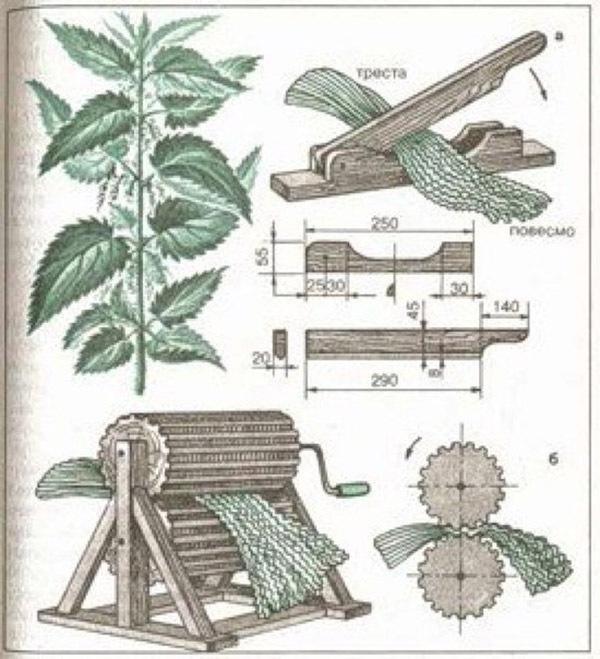

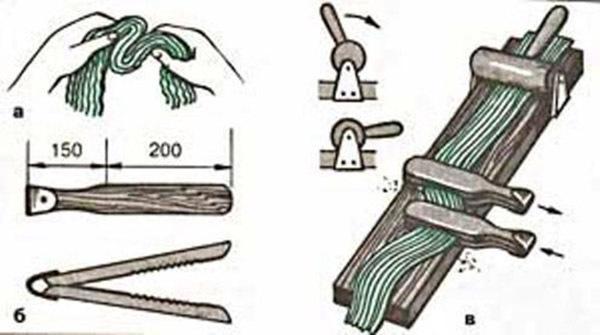

Canvas, woven from yarns kudelnyh, bleached in the dew, and snow, and digested in the liquor - decoction of wood ash. Ropes, twine, burlap, and other similar products izgrebya PABSEC and sometimes soaked day in decoction of oak bark to increase the strength and resistance to spoilage microbes. Sometimes soaked in broth fiber oak stained black. To this end, the rope and burlap dipped in water or a rusty iron sulphate solution. These ancient methods of bleaching and coloring can be successfully used and now, along with the modern.
Author: Gennady Fedotov
Their flexibility and strength long appreciated the bird. For example, the crossbill is always looking for the wren to equip its winter nest.
Sparrow is a no-no, yes and grab nettle fibril for filling random cracks in insulated since the fall of the nest. Spring billet construction material in full swing wren-tit is Remez.
Its nest-cradle hanging over the water on a branch of willow. It is so strong that it is not destroyed for several years. I do not whether these birds craftsmen and advised the man to use a strong elastic fibers nettle?
Like flax and hemp, nettle - one of the oldest fiber plants, which man has learned to handle
.

From long and strong fibers nettle produced yarn for fabric running on tailoring, sails and sacks. From it wove carpets, Vili and ropes, wove fishing nets. On the western shore of Lake Ladoga was found by archaeologists fishing net, woven from the threads of nettle in the Stone Age.
Many will recall Andersen fairy tale about how a girl rescued from the evil spell brothers, turned into wild swans. On the advice of her fairy godmother narwhal nettle, mash it stems napryala strands, and then produced from them-shirt of chain mail that returned a human face brothers. In the fairy tale it reflected old people's faith in the miraculous properties of the fabric of nettle fibers that can supposedly protect people from evil spells and the evil eye, and to heal various diseases. Wonder of nettle yarn to knit socks that are worn for rheumatic pain, belt, used for sciatica and migraine.
Gradually capricious stinging nettles pushed more complaisant flax and hemp. However, the memory of nettles as a fiber plant is still preserved somewhere in the depths of consciousness, sometimes appearing in children's games. In an ethnographic collection of the 19th century, it reported: "In the villages of the province of Ryazan girls spun fibers from nettles to produce thread, which was made from rags dresses for dolls, - finished the mother thread is not allowed." Perhaps, from a pedagogical point of view of the mother acted very wisely, not only because it reminded of the need to save, but because inadvertently teach children to needlework, craft. We can only guess: how the girls became known spinning properties of nettle fibers, which adults have long forgotten
? It is fair to say that nettle fibers were not forgotten by all adults. Even today, they are used for spinning yarn, preferring the purchased, the indigenous people of Kamchatka and the Amur region. Strong and durable thread go on weaving bags, baskets and a variety of boxes. In the manufacture of traditional products used willow twigs, wild rye stalks (tuveyki) and elm along with nettle threads. Quite often used and other fibrous plant growing on vacant lots and burned areas, - Cyprus uzkolisty, popularly called willow-tea
. With harvested in autumn willow-herb stems carefully remove the peel, divide it into fiber, dried and removed for storage. Part of the harvested material are stained broth collected in the swamp moss rusty containing iron oxide black. To make fibers gloss, staining solution added to fish oil. Alternating in a certain order light and dark fiber, masters decorate the surface of articles in geometric patterns.
In the old days of the willow-herb fibers Willy rope, matting produced, horse harness, burlap, and more. In people, the plant is often called wild hemp. This emphasized the similarity of its fibers, hemp fibers, cultivated in our country with the ninth century, called hemp. Nowadays, hemp is indispensable in the manufacture of marine rope, canvas, tarpaulin, fire hoses. But because of the narcotic substances contained in the plant, Hemp fell into disgrace. It is possible that in the near future, scientists will be able to replace it with the cultural views of fireweed uzkolistogo fibers which have similar properties. Perhaps there will turn and nettle, but for now, following the example of our ancestors, produce their own hands krapivnuyu tow.
Nettle tow
All though vaguely heard but how hard it is to harvest and process the flax and hemp. Nettles too, if you do it, as it should be, in the autumn. Then it needs to be dried, then soaked for a long time, again dried, to obtain finally the most trust (the so-called-dried and peeled stalks of fibrous plant), from which it is extracted and spinning fibers. And if you collect nettles in the winter and in the first half of spring, you'll have almost finished trust: nature itself - biting rain, dew, frost, fog and winter thaw has worked for you ...
Brought to the wasteland of nettle stalks should be well dried, spread out on the stove or next to a radiator. Then, remove the twigs and dried leaves. To check the quality of the resulting trusts, knead it with your fingers and is breaking in several places. Ready trust should break apart in his hands with a slight crash, and fiber - separated from the woody parts of the stalk
. OBMINANIE.
The treatment begins with obminaniya trusts her special Myalitsa. On how faithfully mashed stems, yarn quality depends. Not domnesh Mälk, so do not take the spinning wheel - warned the peasant proverb. Myalitsa or Mälk, for the treatment of a small number of trusts in the home, you can make your own - it consists of four parts (Figure 1a.). By the wooden base 20 mm thick attached screws E two boards with saddle notch. From inside the cutout in each field plates mowed at 45 degrees. Lever or beater, slightly tapered bottom and fastened to Myalitsa with the bolt. In turn, strengthen the foundation Myalitsa screws on the bench or any other stable support. For a time in the Myalitsa can knead just one handful of trusts, that is as much as can fit in the hand. Begin to trust press down with one of the ends, put her in the saddle-shaped cut-out with a raised arm. Each time you press and the subsequent lifting of this trust lightly rotate and advance forward slightly. So do as long as a handful of trusts will not be fully obmyata.
Obminanie trusts is more dispute if instead Myalitsa use homemade three-shaft or twin-shaft Mälk (Fig. 1 b). Although the work for them and one can, together still more convenient and faster. One lays the trust between the shafts and the other turns the handle and takes wiped stems, called povesmom.
Trepanier.
To remove from obmyatoy trusts boon - the wooden part of the stem is broken down into small pieces - it swinging special trepalkoy (or trepalom) having the shape of a large wooden knife or mower. Trepalki (Fig. 2a) are cut from solid oak, maple and birch. When applying for trepalkoy povesmu frequent sharp blows, how to knock cleaner jammed in the fibers boon. Then povesmo put on a stump and carefully prokolachivayut (Fig. 2b). Usually after such treatment the remaining shives particles easily flake off. They just have to shake out, striking beam povesma of round wooden stick (Fig. 2) or the edge of the bench.
OSHMYGIVANIE.
Particularly difficult to separate from povesma substances present between the fibers in the upper layer of the stem. They can finally destroy and remove oshmygivaniya way.
To understand the essence of this method, you need to pick up a small bunch obmyatoy and frayed nettle and tightly clenched fingers, rub against each other (Fig. 3a). Usually they are immediately begin to separate and fall down the smallest fines. Freed from these fibers become clean and silky. If you have to handle a considerable amount of povesma, it bundles more comfortable to hold without hands, and tongs (Fig. 3b). Forceps consist of two birch slats connected by a strip of sheet steel. Oshmygivanii At one end of the beam can be clamped in povesma Myalitsa lever-Bill. However, much more convenient to use for this purpose a special clamp to the roller-cam (Fig. 3). Especially because this clip you will need in the next stage of processing fibers - carding. Fixed fiber grab tongs near the clamp. Obshmygivaya section by section, moving gradually from one end to the other. In the next step the fiber bundle is inverted and secured to the other end of the clamp. Now there is only the end of the forceps handle released from the clamp and move on to the carding fibers.
Carding.
Prepared by carding fibers called sliver. Nettle and hemp sliver composed of long, medium and short fibers. The longer the fiber, the thinner and longer than the yarn. To separate the long fibers of the medium and short in the old days used the large maple ridges on a pedestal. But it is especially long and clean the fibers obtained after the re-carding so-called mykalkami - small combs and brushes made of pig bristles. The process of combing and smoothing sliver, or lobes, called closure. He demanded a lot of patience, perseverance; I had carefully combed and smooth out every single strand of fiber. Hence the famous expression "roam", "Woe to knock about" and the like. Nettle fibers set out in the clip, you can comb the conventional metal and plastic combs, commercially available. Before you start scratching gently placed one strand to another. Scratching start with the free end, gradually moving toward the clip (Fig. 4a). At the same time on the comb are short fiber noil - izgreb. Fibres of medium length, comb hair brush, called the PABSEC and the remaining long fibers - tow (Figure 4b.). The fabric obtained from kudelnyh filaments went to sundresses, shirts, tablecloths, towels, bedding and other products tonkotkanye. From izgrebya and PABSEC (otherwise - scum and vychesok) finished yarn that runs on a rough canvas - vatolu, from it sewed quilts, bags, all kinds of litter and capes for the carts. Out of the same fibers were spun and then woven fabric with a rare weave - spindles and ryadninu, used for household needs
. Of coarse fibers that were not treated oshmygivaniem and scratching, it Wylie, Wylie ropes and cables, used as a tow to reach between the crowns of log house, as well as caulking grooves between the logs.




Canvas, woven from yarns kudelnyh, bleached in the dew, and snow, and digested in the liquor - decoction of wood ash. Ropes, twine, burlap, and other similar products izgrebya PABSEC and sometimes soaked day in decoction of oak bark to increase the strength and resistance to spoilage microbes. Sometimes soaked in broth fiber oak stained black. To this end, the rope and burlap dipped in water or a rusty iron sulphate solution. These ancient methods of bleaching and coloring can be successfully used and now, along with the modern.
Author: Gennady Fedotov





